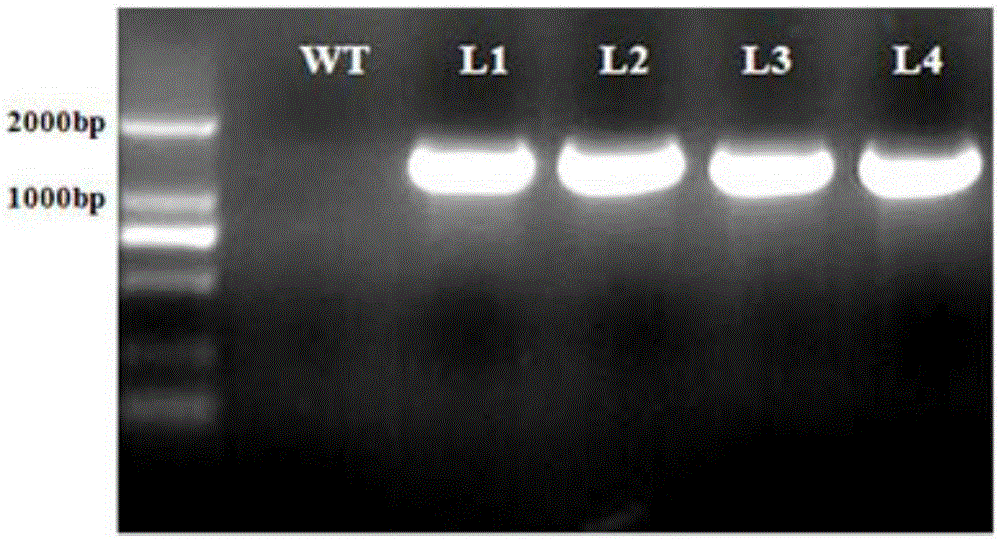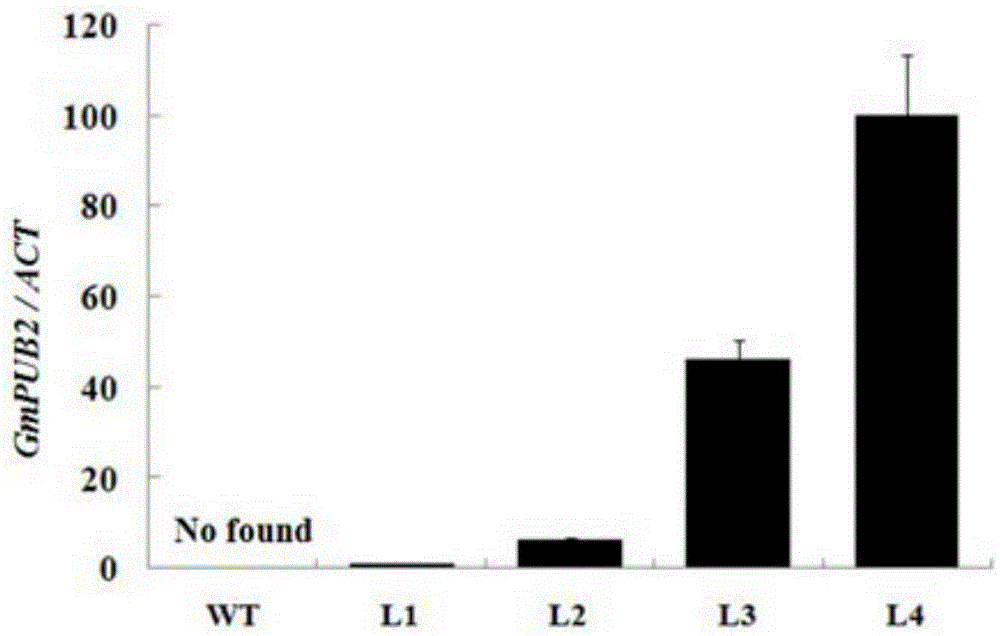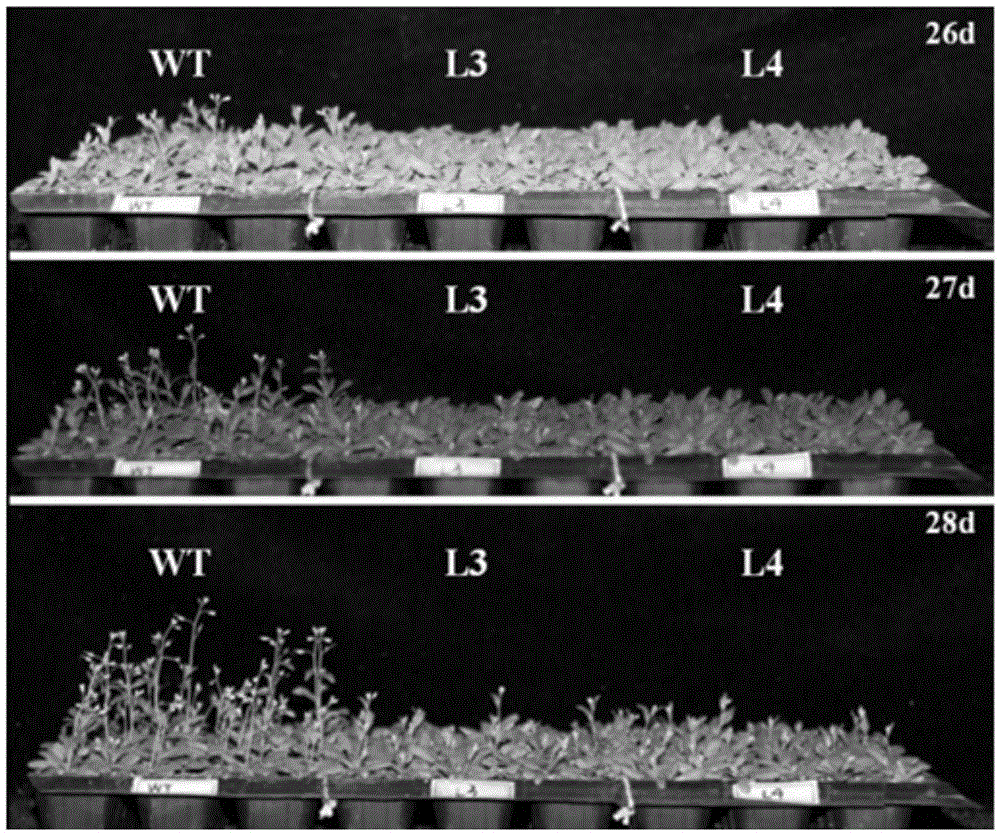Application of soybean E3 ubiquitin ligase gene GmPUB2 capable of regulating flowering of plants
A ubiquitin ligase and plant technology, applied in the field of biogenetic engineering, can solve the problems such as the unseen soybean E3 ubiquitin ligase
- Summary
- Abstract
- Description
- Claims
- Application Information
AI Technical Summary
Problems solved by technology
Method used
Image
Examples
Embodiment 1
[0028] Embodiment 1: Obtaining of GmPUB2 gene
[0029] 1. RNA extraction:
[0030] (1) Sample processing: collect about 100 mg of soybean leaf tissue, grind it in liquid nitrogen, add 1 mL of lysate RZ, shake and mix.
[0031] (2) Place the homogenized sample at room temperature for 5 minutes to completely separate the nucleic acid-protein complex.
[0032] (3) Centrifuge at 12,000 rpm for 5 minutes at 4°C, take the supernatant, and transfer it to a new RNase-free centrifuge tube.
[0033] (4) Add 200 μl of chloroform, cover the tube cap, shake vigorously for 15 sec, and place at room temperature for 3 min.
[0034] (5) 4°C, 12000rpm centrifuge for 10min, the sample will be divided into three layers: RNA is mainly in the water phase, transfer the water phase to a new tube, and proceed to the next step.
[0035] (6) Slowly add 0.5 times the volume of absolute ethanol, mix well, transfer to the adsorption column CR3, centrifuge at 12000rpm at 4°C for 30sec, and discard the wa...
Embodiment 2
[0062] Embodiment 2: Construction of plant expression vector
[0063] 1. Obtaining of attB-GmPUB2 product
[0064] According to the Gateway system, linkers attB1 and attB2 are added to the 5' end of the specific primers for amplifying the target gene, and then the DNA is amplified with KOD polymerase to amplify the full-length fragment of the target gene with the linker (attB).
[0065] attB1+GmPUB2F2: 5'‐GGGGACAAGTTTGTACAAAAAAGCAGGCT‐3' (SEQ ID NO.5)
[0066] attB2+GmPUB2R2: 5'‐GGGGACCACTTTGTACAAGAAAGCTGGGT‐3' (SEQ ID NO.6)
[0067] Soybean cDNA was used as a template, and attB1+GmPUB2F2 and attB2+GmPUB2R2 were used as upstream and downstream primers for PCR amplification. The PCR conditions were 94°C for 2min, 94°C for 30sec, 68°C for 2min, 35 cycles, and 68°C for 5min. After the PCR product was sent to BGI for sequencing verification, it was separated and analyzed with 1.0% agarose gel, and the target fragment was recovered and purified.
[0068] 2. Construction of entry...
Embodiment 3
[0076] Example 3: Transformation of Arabidopsis and verification of transgene function
[0077] 1. Transformation of Agrobacterium with pMDC83‐GmPUB2 vector
[0078] Extract the pMDC83-GmPUB2 plasmid, mix it with Agrobacterium EHA105, and transform it by freeze-thaw method. Positive clones were screened on LB medium containing 50 mg / L Rif and 50 mg / L Kan. Then use the upstream primer F1 of GmPUB2 and the downstream primer R1 of GmPUB2 as primers to carry out PCR amplification to detect whether the selected single clone contains the target gene fragment. After the verified clones were multiplied, they were stored at -80°C for later use.
[0079] 2. Genetic Transformation of Arabidopsis
[0080] (1) Seed disinfection: Soak Arabidopsis wild-type seeds in a 1.5mL centrifuge tube containing 1mL deionized water, place it at 4°C for 2 days, take it out, wash it twice with sterilized water in an ultra-clean bench, and suck it away water. Add 75% alcohol to the centrifuge tube, an...
PUM
 Login to View More
Login to View More Abstract
Description
Claims
Application Information
 Login to View More
Login to View More - R&D
- Intellectual Property
- Life Sciences
- Materials
- Tech Scout
- Unparalleled Data Quality
- Higher Quality Content
- 60% Fewer Hallucinations
Browse by: Latest US Patents, China's latest patents, Technical Efficacy Thesaurus, Application Domain, Technology Topic, Popular Technical Reports.
© 2025 PatSnap. All rights reserved.Legal|Privacy policy|Modern Slavery Act Transparency Statement|Sitemap|About US| Contact US: help@patsnap.com



